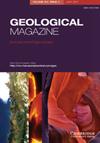苏格兰Dob 's Linn的奥陶系-志留系界线有多古老?LA-ICP-MS和CA-ID-TIMS U-Pb锆石日期整合研究
IF 2
3区 地球科学
Q3 GEOSCIENCES, MULTIDISCIPLINARY
引用次数: 0
摘要
在苏格兰的多布林恩(Dob’s Linn)暴露出来的沉积岩,对我们了解奥陶纪到早志留纪的生命进化过程产生了重大影响。目前解释的奥陶系和志留系的年代地层边界是一个全球边界层型剖面和点(GSSP),基于生物地层标记、放射性同位素日期和统计模拟,校准为443.8±1.5 Ma (Hirnatian-Rhuddanian年龄)。然而,由于构造扰动、复杂的对比问题以及奥陶系-志留系地层剖面缺乏系统的测年,研究工作面临挑战。在这里,使用激光烧蚀电感耦合等离子体质谱(LA-ICP-MS)测定了来自三个变质膨润土灰层的数百颗锆石颗粒的年代。使用化学磨损同位素稀释热电离质谱法(CA-ID-TIMS)重新分析了一部分颗粒。我们提出了高精度CA-ID-TIMS 238U-206Pb加权平均日期为440.44±0.55/0.56/0.72 Ma(±分析/带示踪/带u衰变常数)。然而,该研究报告了在Coronagraptus cyphus, Akidograptus ascensus和Dicellograptus anceps带中更年轻,在某些情况下,更古老的LA-ICP-MS锆石,怀疑是受Pb损失和LA-ICP-MS基体不匹配的影响。该研究报告了Dob’s Linn作为GSSP剖面的适用性,并检查了各种LA-ICP-MS最大沉积年龄(MDA)方法,建议使用TuffZirc日期和最年轻模式加权平均值(YMWM)作为与CA-ID-TIMS结果一致的合适的MDA计算。本文章由计算机程序翻译,如有差异,请以英文原文为准。
How old is the Ordovician–Silurian boundary at Dob’s Linn, Scotland? Integrating LA-ICP-MS and CA-ID-TIMS U-Pb zircon dates
Sedimentary rocks exposed at Dob’s Linn, Scotland, have significantly influenced our understanding of how life evolved over the Ordovician to Early Silurian. The current interpreted chronostratigraphic boundary between the Ordovician and Silurian periods is a Global Boundary Stratotype Section and Point (GSSP), calibrated to 443.8 ± 1.5 Ma (Hirnatian–Rhuddanian age), based on biostratigraphic markers, radioisotopic dates and statistical modelling. However, challenges arise due to tectonic disturbances, complex correlation issues and the lack of systematic dating in Ordovician–Silurian stratigraphic sections. Here, hundreds of zircon grains from three metabentonite ash horizons were dated using Laser Ablation Inductively Coupled Plasma Mass Spectrometry (LA-ICP-MS). A subset of the grains were re-analyzed using Chemical Abrasion Isotope Dilution Thermal Ionization Mass Spectrometry (CA-ID-TIMS). We present a high-precision CA-ID-TIMS 238 U-206 Pb weighted mean date of 440.44 ± 0.55/0.56/0.72 Ma (±analytical/with tracer/with U-decay constant) for the Coronagraptus cyphus biozone. However, the study reports younger, and in certain cases, older LA-ICP-MS zircon dates within the Coronagraptus cyphus , Akidograptus ascensus and Dicellograptus anceps zones, suspected as being influenced by Pb loss and LA-ICP-MS matrix mismatch. The study reports concerns about the suitability of Dob’s Linn as a GSSP section and examines various LA-ICP-MS maximum depositional age (MDA) approaches, suggesting the use of the TuffZirc date and the youngest mode weighted mean (YMWM) as suitable MDA calculations consistent with CA-ID-TIMS results.
求助全文
通过发布文献求助,成功后即可免费获取论文全文。
去求助
来源期刊

Geological Magazine
地学-地球科学综合
CiteScore
4.70
自引率
0.00%
发文量
111
审稿时长
3 months
期刊介绍:
Geological Magazine, established in 1864, is one of the oldest and best-known periodicals in earth sciences. It publishes original scientific papers covering the complete spectrum of geological topics, with high quality illustrations. Its worldwide circulation and high production values, combined with Rapid Communications and Book Review sections keep the journal at the forefront of the field.
This journal is included in the Cambridge Journals open access initiative, Cambridge Open Option.
 求助内容:
求助内容: 应助结果提醒方式:
应助结果提醒方式:


